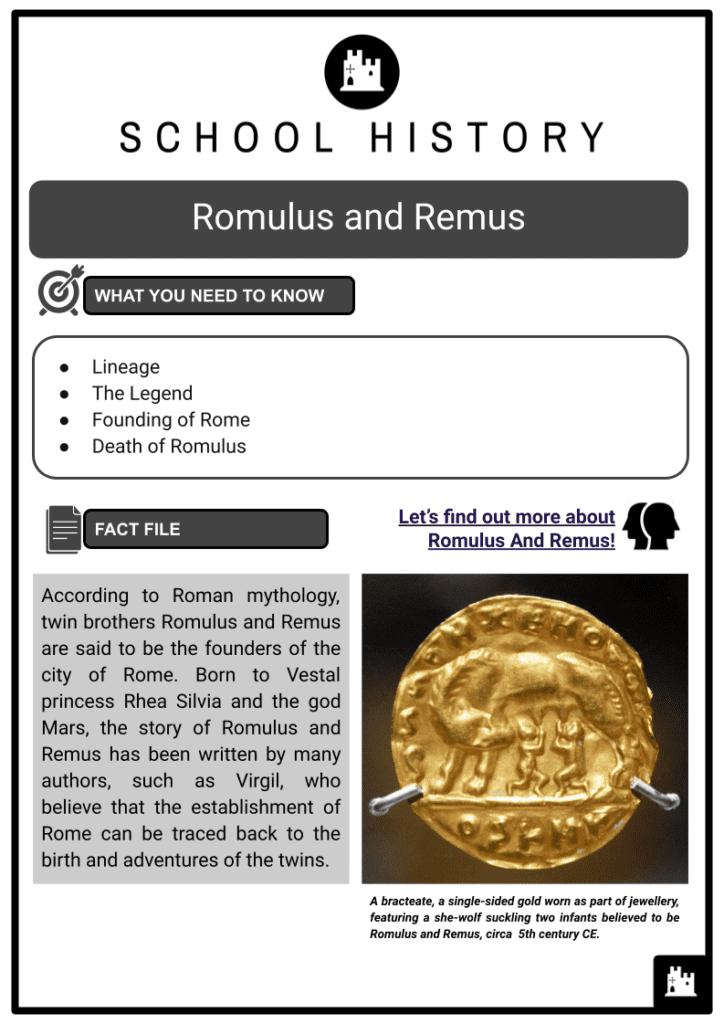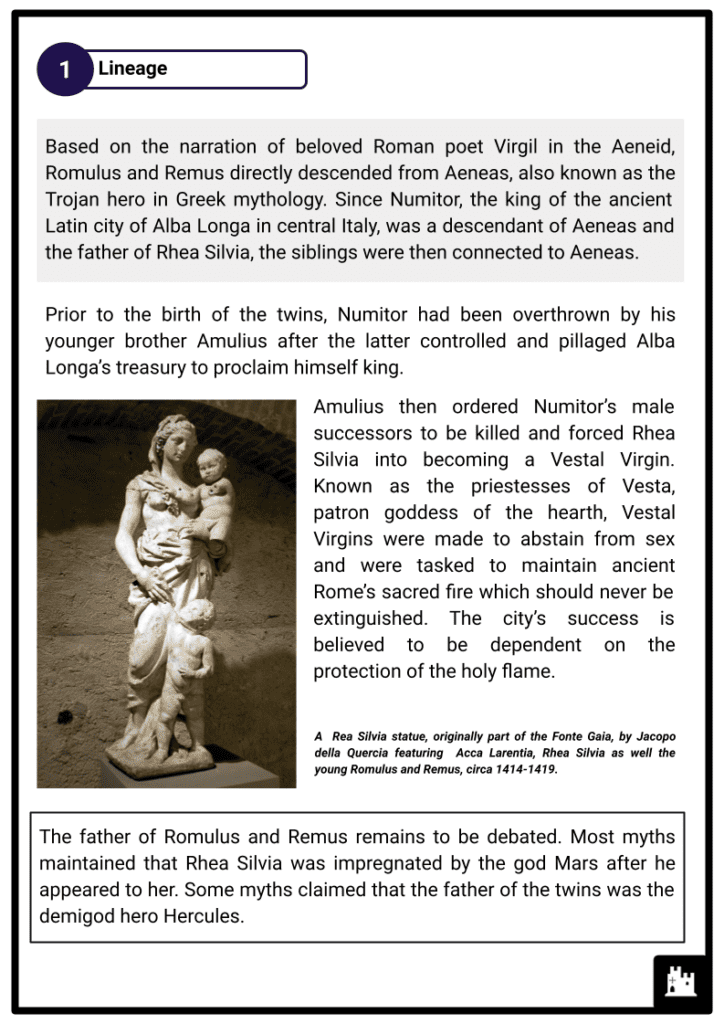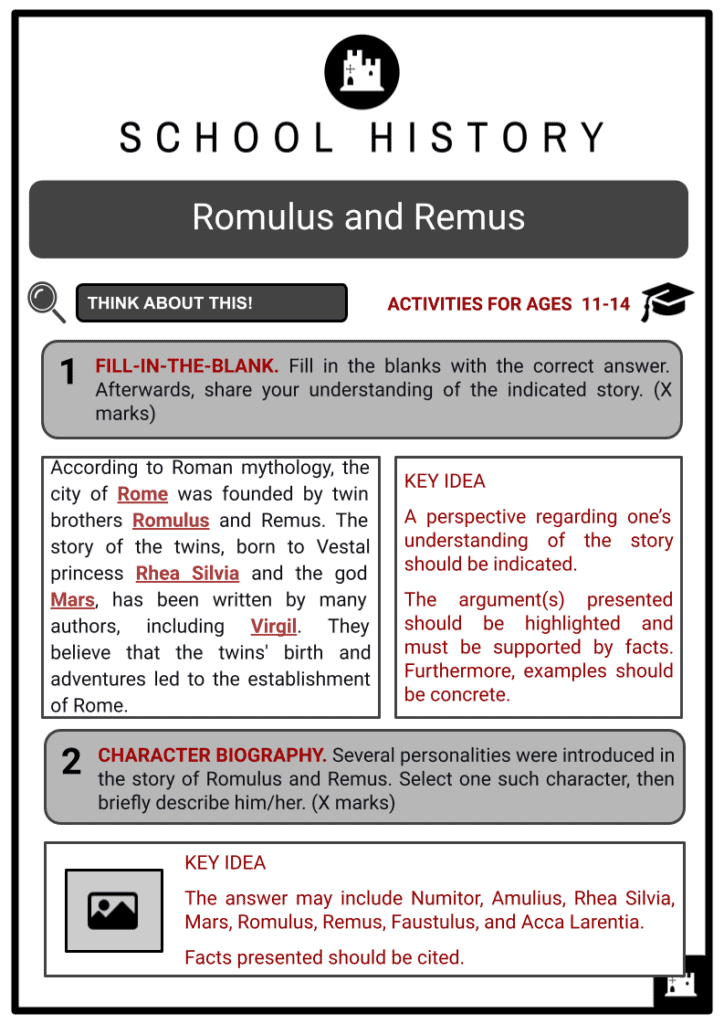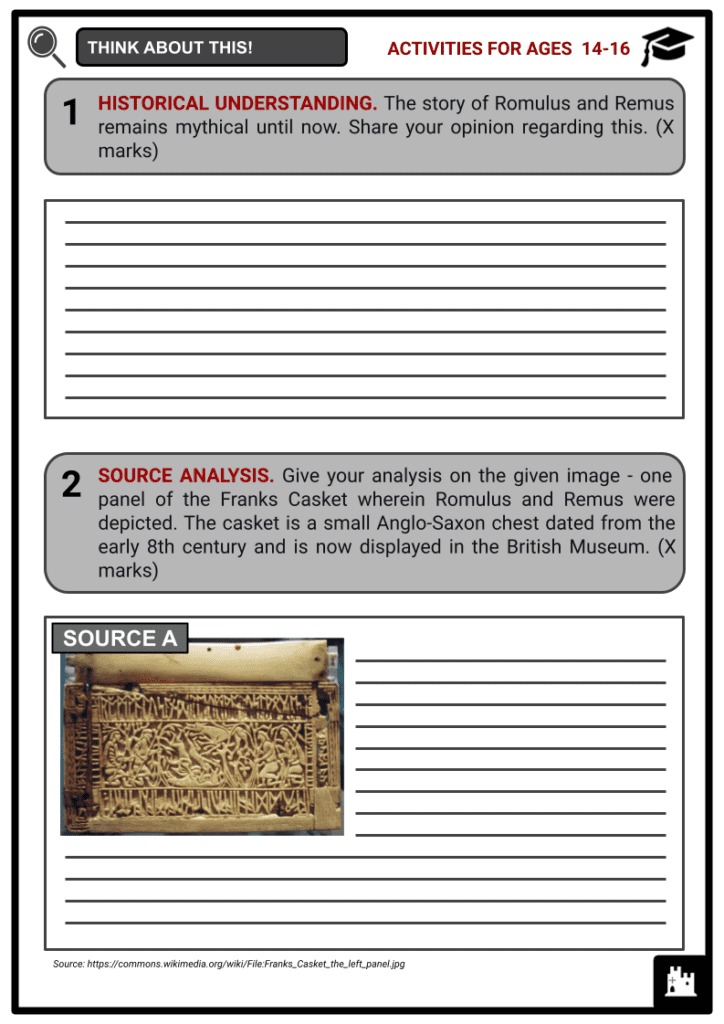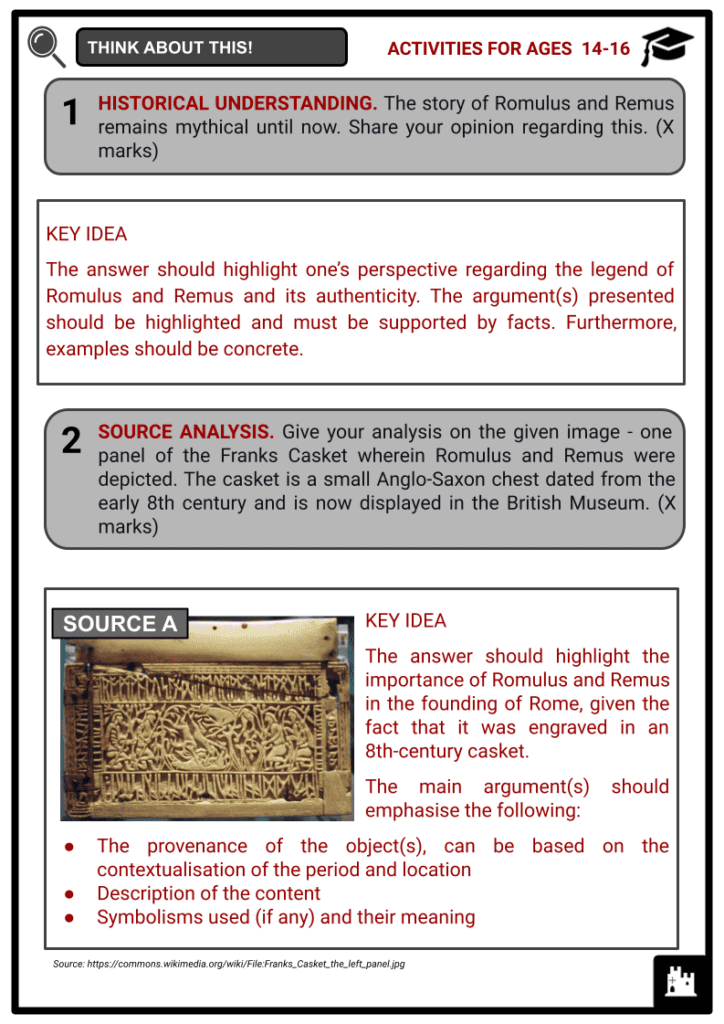Romulus and Remus Worksheets
Do you want to save dozens of hours in time? Get your evenings and weekends back? Be able to teach about Romulus and Remus to your students?
Our worksheet bundle includes a fact file and printable worksheets and student activities. Perfect for both the classroom and homeschooling!
Summary
- Lineage
- The Legend
- Founding of Rome
- Death of Romulus
Key Facts And Information
Let’s find out more about Romulus and Remus!
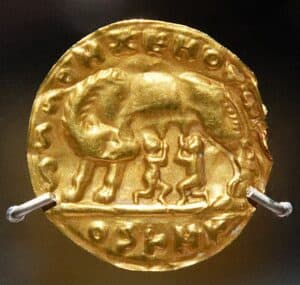
According to Roman mythology, twin brothers Romulus and Remus are said to be the founders of the city of Rome. Born to Vestal princess Rhea Silvia and the god Mars, the story of Romulus and Remus has been written by many authors, such as Virgil, who believe that the establishment of Rome can be traced back to the birth and adventures of the twins.
Lineage
- Based on the narration of beloved Roman poet Virgil in the Aeneid, Romulus and Remus directly descended from Aeneas, also known as the Trojan hero in Greek mythology. Since Numitor, the king of the ancient Latin city of Alba Longa in central Italy, was a descendant of Aeneas and the father of Rhea Silvia, the siblings were then connected to Aeneas.
- Prior to the birth of the twins, Numitor had been overthrown by his younger brother Amulius after the latter controlled and pillaged Alba Longa’s treasury to proclaim himself king.
- Amulius then ordered Numitor’s male successors to be killed and forced Rhea Silvia into becoming a Vestal Virgin. Known as the priestesses of Vesta, patron goddess of the hearth, Vestal Virgins were made to abstain from sex and were tasked to maintain ancient Rome’s sacred fire, which should never be extinguished. The city’s success is believed to be dependent on the protection of the holy flame.
- The father of Romulus and Remus remains to be debated. Most myths maintained that Rhea Silvia was impregnated by the god Mars after he appeared to her. Some myths claimed that the father of the twins was the demigod hero Hercules.
- Roman historian Titus Livius, also known as Livy, believed that an unknown man raped Rhea Silvia, but the Vestal Virgin claimed that it was due to divine conception.
- The mystery still unresolved, Rhea Silvia gave birth to twins. Because the Vestal Virgin breached her vows of chastity, she was supposed to be sentenced to death.
- Fearing the possible punishment of either Mars or Hercules, King Amulius sent Rhea Silvia to jail and, to avoid any conflict of power, ordered the killing of Romulus and Remus through live burial, exposure, or being thrown into the Tiber River. Amulius believed that if the twins would not die by the sword, they would not suffer the wrath of the gods.
- A servant, taking pity on the boys, decided to leave them in a basket on the Tiber River.
The Legend
- According to the myth, Romulus and Remus were brought to safety because the river god Tiberinus calmed the Tiber River.
- The boys were found near a fig tree situated at the Palatine Hill’s base in the Velabrum swamp. It is said that a she-wolf or Lupa first discovered the twins and that a woodpecker or Picus fed them. Following this, a shepherd named Faustulus and his wife Acca Larentia took care of and raised the siblings.
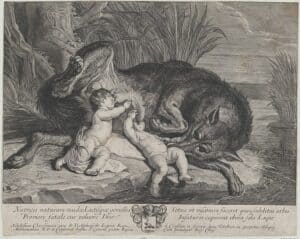
According to myth, Romulus and Remus are said to have been discovered by a she-wolf or lupa near a fig tree on the Palatine Hill. - One day, Romulus and Remus, who also became shepherds like their adoptive father, encountered King Amulius’ shepherds. The shepherds confronted the wins and fought with them. Remus was caught and eventually sent to the king. Amulius did not recognise him. During that time, Romulus asked help from his fellow shepherds to save his brother. Romulus rescued Remus and eventually killed King Amulius.
- Following Amulius's death, the crown of Alba Longa was offered to the twins, but they refused it. Numitor was later back on the throne.
- Romulus and Remus left the city to find their own. Romulus wanted to establish their rule and build the city on Palatine Hill. Remus, meanwhile, wanted to build it on Aventine Hill.
- To solve the conflict, they consulted augury, a type of prophecy involving the interpretation of birds’ flight patterns. But the disagreement was not settled. Romulus said he saw twelve birds, but Remus said he saw six.
- The conflict remained until, one day, Romulus decided to dig trenches and establish walls on Palatine Hill.Remus made fun of his brother’s construction and even jumped over the wall. Romulus was offended by Remus’ mockery, so he killed him.
Founding of Rome
- Most sources maintained that Romulus indeed killed Remus. In Livy’s version, Remus died on 21 April of 753 BCE. It was also the time when Rome was founded.
- Remus’ death is open to debate. On the one hand, Livy said that, after jumping over his brother’s wall, Remus was fated to die as a sign of the Roman gods’ power.
- On the other hand, St. Jerome claimed that one of the servants of Romulus, either Fabius or Celer, in fact, killed Remus after throwing a spade at his head. Then, later on, Romulus mourned and buried his brother with full funeral honours.
- Naming the city Roma after himself, Romulus established a government system led by patricians and senators. The city’s population quickly grew, but fugitives, exiles, runaway slaves, and criminals mostly composed the population. It was also dominated by males.
- Unable to reproduce from their own lineage, Roman men planned to abduct women from the neighbouring city of the Sabines. They invited the Sabines alongside the Latins to the Cronus festival at the Circus Maximus. They then killed the men and kept the women and forced them to marry.
- In retaliation, Titus Tatius, king of the Sabines, engaged in a war with the Romans. The Latins also declared war on Rome. Romulus eventually claimed victory after seeking help from Jupiter.
- The Sabines and Romans reached a truce, creating a joint kingship of Tatius and Romulus. The shared rule only lasted five years after Tatius protected his allies who ransacked the neighbouring Lavinium and killed their ambassadors. As a result, Tatius was sent to Lavinium where he was murdered. He was buried on Mount Aventine.
- Romulus then solely ruled Rome for the next 20 years and began the city’s expansion efforts, including the integration of Alba Longa into Rome after the death of Numitor.
Death of Romulus
- The death of Romulus is surrounded by many claims. A myth says that Romulus died during a storm or whirlwind. It is also said that witnesses saw the king ascending to the heavens and eventually turning into a god. Other sources claim that Rome’s senate ordered the killing of Romulus to gain more power.
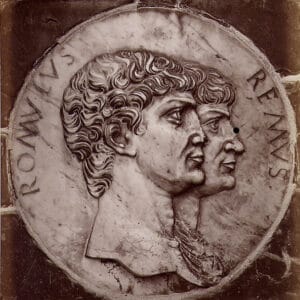
A 15th century medallion featuring Romulus and Remus. - Greek philosopher Plutarch believes that Romulus mysteriously disappeared in 717 BCE at age 53. However, Dionysius of Halicarnassus claims that Romulus died at age 55.
- Until today, the story of Romulus and Remus remains highly mythical. Some scholars say that while Aeneas from whom Rome’s establishment began may have appeared in folktales, Roman mythology was only put into writing after Augustus commissioned Virgil’s Aeneid.
Greek Origins
- According to other ancient sources, the foundation of the city would have a link with the Greek world since the founders had Trojan ancestry.
- The legend presents Aeneas, the Trojan prince, as one of the direct ancestors of Romulus and Remus, who also became king after marrying the daughter of the Latin king.
- This interpretation is not only found in the theories of Greek historians but this thesis is also defended in the Italic world, which is confronted with other myths attributing its origin to Arcadius or Achéos. Be that as it may, Greek historiography has attributed divine and Greek origins to the founding of Rome. However, the Trojan origin of Rome is hardly acceptable if we compare the date of the destruction of Troy (1200 BC) with the archaeological remains of the village of Latium and Septimontium.
Image Sources
- https://commons.wikimedia.org/wiki/File:Bracteate_she-wolf_NMAT_KP208-243_(cropped).jpg
- https://commons.wikimedia.org/wiki/File:Romulus_and_Remus_suckling_the_she-wolf_on_a_riverbank_MET_DP878752.jpg
- https://commons.wikimedia.org/wiki/File:Brogi,_Carlo_(1850-1925)_-_n._8226_-_Certosa_di_Pavia_-_Medaglione_sullo_zoccolo_della_facciata.jpg

